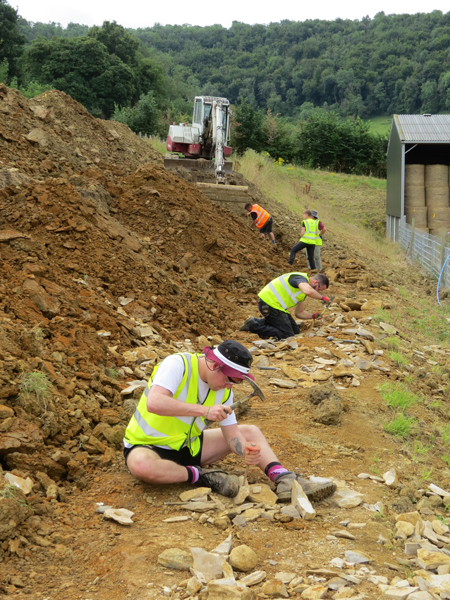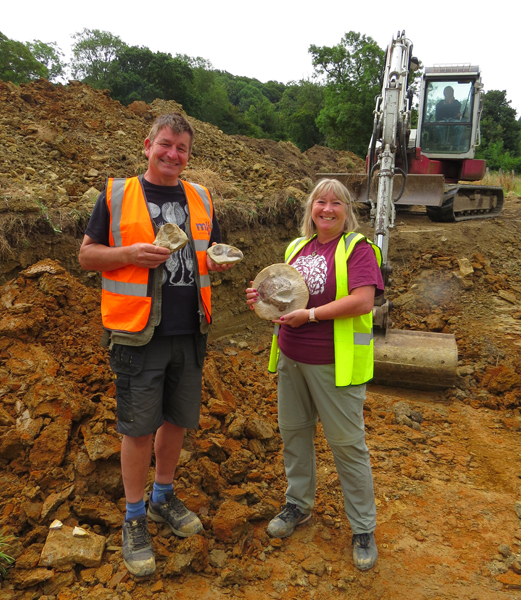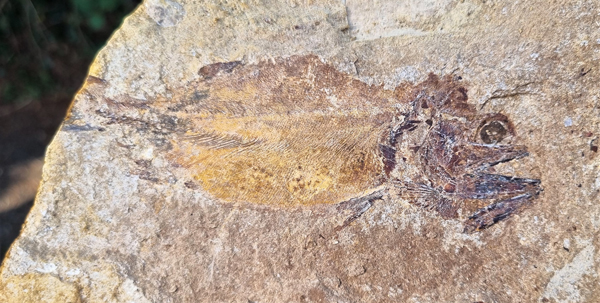A farmer’s field in rural Gloucestershire (England), has provided palaeontologists with a remarkable glimpse into an Early Jurassic marine ecosystem.
Underneath a grassy bank, normally grazed by cattle at Court Farm, Kings Stanley near Stroud, lies an exceptional fossil site that contains the remains of fish, ammonites, squid, marine reptiles and other creatures, with many of the specimens preserved in three dimensions.

A Toarcian Ecosystem
The clays and hard limestone nodules, many of which contain fossils, were deposited around 183 million years ago (Toarcian stage of the Early Jurassic).
The site was discovered by Sally and Neville Hollingworth, avid fossil collectors who recently uncovered the remains of mammoths in the nearby Cotswold Water Park which was featured in the BBC One documentary “Attenborough and the Mammoth Graveyard” in 2021.
Commenting on the significance of this location, enthusiastic fossil hunters Neville and Sally stated:
“These fossils come from the Early Jurassic, specifically a time called the Toarcian. The clay layers exposed at this site near Stroud have yielded a significant number of well-preserved marine vertebrate fossils that are comparable to the famous and exquisitely preserved similar fauna of the Strawberry Bank Lagerstätte from Ilminster, Somerset – a prehistoric site of exceptional fossil preservation. Excavations at Kings Stanley over the last week have revealed a rich source of fossil material, particularly from a rare layer of rock that has not been exposed since the late 19th century.”
Limestone Concretions
A team of eight scientists spent a total of four days working to clear an area of the bank approximately eighty metres in length. An excavator proved invaluable, but the field team still had to endure record breaking temperatures as they laboured to find and crack open three-dimensionally preserved limestone concretions, many of which contained fossils.

Each specimen was carefully logged onto a database and approximately 200 kilograms of clay from around the concretions was also collected and carefully sieved using a state-of-the-art sediment processing machine to help locate microvertebrate fossils such as fish teeth and small bones.

Fossils Donated to Local Museum
Many of the fossils found at the site will be donated to the palaeontology collection of a local museum (The Museum in the Park, Stratford Park, Stroud).
Team member and world-renowned, palaeontological conservator Nigel Larkin (Visiting Research Fellow at Reading University) commented:
“Give a person a fish and you feed them for a day. Give a palaeontologist a fossil fish and they will tell you the species, the age of the rock, the climate of the time when the fish was alive plus the water depth and salinity and plenty of other information. This site – already an interesting farm in a beautiful setting – is one big outdoor classroom and the lessons now include geology, palaeontology, evolution and climate change. They tell farmers to diversify but this goes one step beyond!”
Exceptional Fossil Fish Finds
Some of the best finds include fossil fish, so well-preserved that details of the scales, fins and even their eyeballs can be made out. One of the most impressive discoveries was a three-dimensionally preserved fish skull, a Pachycormus, (see first image), a genus of ray-finned fish known from the Toarcian of Europe.
The lack of any signs of scavenging of the corpses and the absence of encrusting animals or burrows in the sediment suggest that the fauna which was frozen in time under a farmer’s field was rapidly buried.

Splitting Concretions to Find Fossil Fish and Other Remains
The layered concretions around the organisms formed relatively early before the sediments were compacted, as the original sediment layering is preserved. These concretions prevented further compaction, compression and distortion from the overlying sediments during burial and thus preserved the fossils as three-dimensional time capsules.
Dr Dean Lomax, a palaeontologist and a Visiting Scientist at the University of Manchester, who recently led the excavation of the Rutland ichthyosaur that also dates to the Toarcian geological age, was part of the team he explained:
“The site is quite remarkable, with numerous beautifully preserved fossils of ancient animals that once lived in a Jurassic sea that covered this part of the UK during the Jurassic. Inland locations with fossils like this are rare in the UK. The fossils we have collected will surely form the basis of research projects for years to come.”
To visit the website of Dr Dean Lomax: British Palaeontologist Dr Dean Lomax.
Landowner, Adam Knight, who has seen part of his farm temporarily converted into a real life “Jurassic Park” added:
“I’m delighted that after the initial work that Sally and Nev did over three years ago we now have a full-scale dig on the farm involving a range of fossil experts from The Natural History Museum, University of Manchester, University of Reading and The Open University. On Friday we were also joined by Emily Baldry on a day’s work experience before she goes to university to study palaeontology – it’s wonderful to see her enthusiasm for her chosen profession. It has been a real pleasure to host the dig and I’m excited to see the results of what has been found.”
Important Microvertebrates and Fossil Insects
Dr David Ward (research scientist at the Natural History Museum, London), outlined his contribution to the fieldwork explaining that his role was to collect evidence of all the small creatures that lived alongside the larger vertebrates and invertebrates in the ancient marine ecosystem.
The silty clay found in association with the limestone concretions was carefully washed and pushed through a fine sieve. Dr Ward’s wife Alison played a vital role in the collection process, and she added:
“My specialism is surface picking. This involves finding areas where fossils, particularly small bones and teeth, are naturally concentrated on the surface. Here, once I had collected them, I dug up the surrounding clay and fed it into David’s clay washing machine. The result is a fine concentrate of tiny fish bones and shells which we sort under a microscope.”
The Basis for a PhD
For Open University PhD student Emily Swaby, this fossil site has very special significance. Her PhD research is focused on how insects were affected by dramatic environmental changes that took place during the Toarcian. Fossil insects are extremely rare and although the Court Farm site represents marine deposition, insect fossils are known from such locations.
Emily commented:
“Further research at this site and surrounding Gloucestershire localities might help us to work out the abundance and diversity of insects during this time and help us to understand how this environmental change influenced insects.”
Everything Dinosaur acknowledges the assistance of a media release from the University of Manchester and additional information supplied by Dr Dean Lomax in the compilation of this article.










Leave A Comment